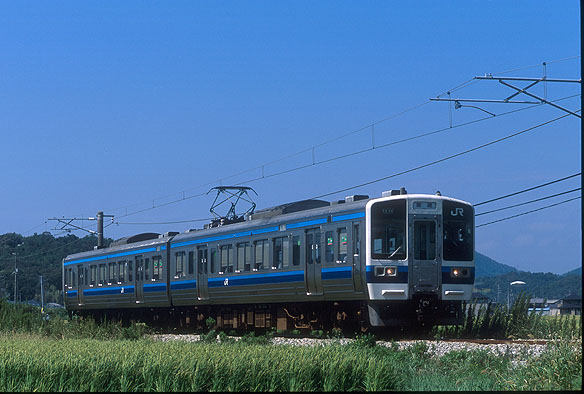Background and overview
Japanese National Railways (JNR) which developed 211 series were developing
the new suburban electric multiple unit (EMU) train adopting 1M system
in order to make short formations for provincial city area. Then JNR developed
213-0 series suburban DC electric multiple unit (EMU) trains in order to
use on the rapid services of the Seto-Ohashi line. 213-0 series don't adopt
married pair unit system but single unit system for rural transportation.
Car body
They have 2950mm wide body, incorporating light weight stainless construction.
They have the double blue and light blue waistline and blue headline bands
running the length of each car below and above the windows. Cab ends are
covered with a Fiber Reinforced Plastics (FRP) panel and electrolytic colouring
aluminum black plates are fitted above and below windshields. Left windshield
panel is expanded below to provide an excellent outside view to the passengers.
They are equipped with 2 double-leaf automatic sliding doors on each side
of the vehicles and pairs of drop windows. Door operating equipments, TK111,
are fitted above the door header of the sliding doors. An air conditioner,
AU79A rated at 33,000kcal/h, is fitted on the centre of their roof. Forced
draft ventilators are fitted on the both side of the air conditioner. Traditional
roller-binding destination screens and loudspeakers, providing guidance
broadcast for passengers waiting at a station, are fitted on each side
of the body. End cars are equipped with the automatic jumper coupler to
ease rush-up operations.
Bogies
Their bogies are DT50B/TR235B featuring bolster-less secondary air suspension,
corn-shaped multilayered rubber spring journal supporting system, and double
collar sealed roller bearing for improved stability at high speed. Traction
device of the bogie is multilayered rubber spring.
Traction unit and auxiliary equipments
The terminal voltage of series-wound brushed DC traction motors, MT64, is 750VDC to realize single unit system. The gear ratio is 5.19 to get high traction force at starting and wide speed range of regeneration braking. Four traction motors of Kumoha213 are controlled by armature-resistance traction control system, CS59, featuring field added excitation control. At the armature voltage control stage, armature resistance control and series-parallel control are applied. At the field weakening stage, field added excitation system, HS60, indirectly controls the electrical current of field by controlling the electrical current of inductive shunt. Forced field control by HS60 realizes regenerative braking. At low-speed range, the voltage of regeneration keeps by applying series-parallel control. If the regenerative brake is not sufficient, additional brake is provided by pneumatic friction brake. Class Kumoha213 vehicles are equipped with a diamond-shaped current collector, PS21, an auxiliary power supply featuring a boost converter, SC22, with a power output of 110kVA, and a motor driven air compressor, MH3075A-C2000M. The brake system is the electric command pneumatic brake.
Accommodation
Passenger accommodation is switchable transverse seating with 910mm seating
pitch throughout. An AC duct is installed above the ceiling and slit-shaped
AC vents are featured in order to improve interior design. Stanchion poles
are fitted immediately inside the doors. Class Kuha212 vehicles are equipped
with a Japanese style toilet having a chemical disposable tank.
After the splitting of the former JNR into the new privatized JR companies in April 1987, JR West received 213-0 series vehicles.
JR West delivered additional 213-0 series vehicles used on "Marine
Liner" rapid services for the start of services of the Seto-Ohashi
Line in 1988. Furthermore, JR West developed 1st class end cars, Class
Kuro212, featuring 180 degree "Panoramic" seating view.
Panoramic 1st class cars developed by JR West
Kuro212 vehicles are constructed by steel, having stream-line shaped end
section. A very large windscreen and a glass partition between a cab section
and a passenger room provide an excellent outside view to the passengers.
Their livery is white with a thin, horizontal blue and pink/yellow/green
bands below the windows. They are equipped with an 800mm wide single-leaf
automatic sliding door and large panorama windows on each side of the vehicles.
An air conditioner, WAU301 rated at 33,000kcal/h, is fitted under the floor.
Their bogies are WTR235B featuring bolster-less air suspension and corn-shaped
multilayered rubber spring.
Their seats are able to face side windows to make easy to see beautiful
seascape when the train is taking across Seto-Ohashi Bridge.
Operations
Although 213 series had been used on rapid services of the Seto-Ohashi
line from 1988, 213 series were replaced with 223-5000 series/5000 series
in 2003.
Modification and refurbishment
Although the formations of 213 series were 3 cars, the formations were reduced to 2 cars in order to use in Okayama region. Since there are not enough end cars, some 2-car formations were formed by joining the cab sections onto trailer intermediate cars, Saha213-0. Remodeled end cars were classified into Kuha212-100. Kuha212-100 vehicles have a universal access toilet and wheel chair space near the motorman's cab.
2-car sets of 213-0 series were modified for use on conductor-less operation services from 2004. The ticket machine, which put the ticket indicating the boarding station, is located at the boarding doors. The fare display and the fare box are located behind the motorman's cab. Seatings behind the motorman's cab were removed.
From 2012, The refurbishment was commenced with the same accommodation
as 223 series by JR west. Refurbished 213-0 series vehicles feature LED
destination indicators, a universal access toilet, wheel chair spaces,
semi-automatic doors which can open or close manually by pushing buttons,
discontinuing ventilators on the floor, and passenger information displays
on the door lintels.
Latest operation status
213-0 series are now used on the ordinary services of Sanyo, Ako, Uno and
Hakubi lines. |
|









